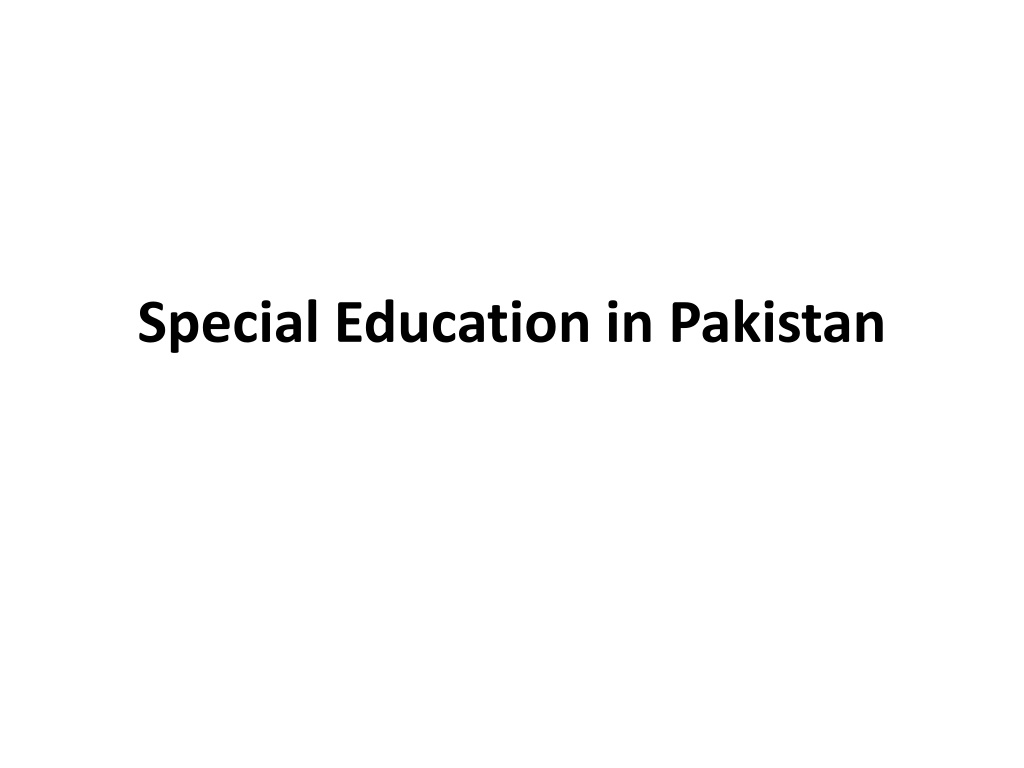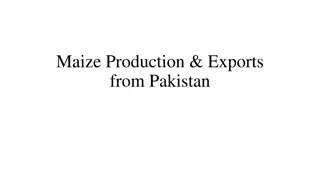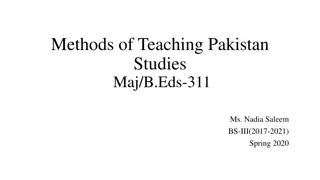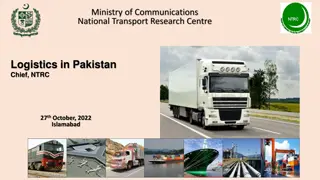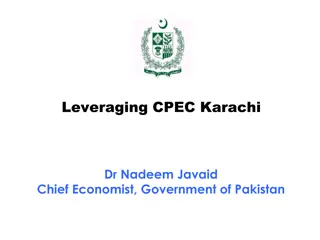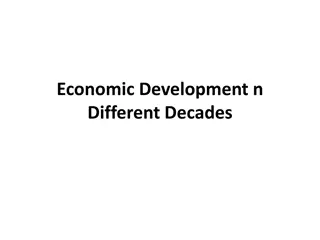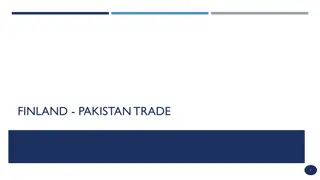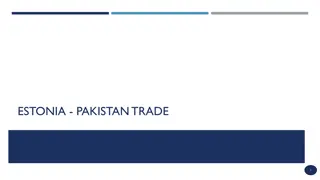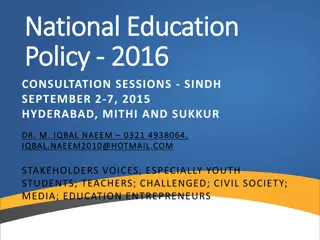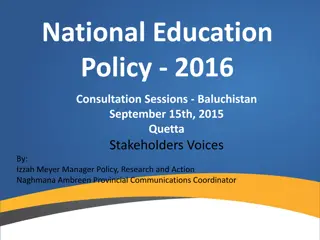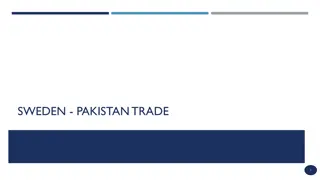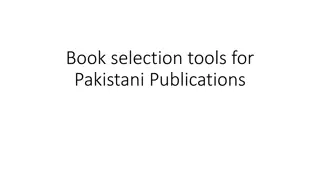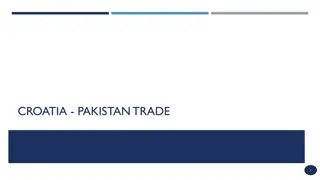Challenges and Progress of Special Education in Pakistan
Special education in Pakistan has faced challenges due to lack of emphasis and resources, dating back to independence. Initiatives were proposed in reports like the Commission on National Education (1959), highlighting the need for specialized training for teachers and collaboration between government and social organizations. Despite delays, efforts eventually materialized in policies like the Education Policy 1972-1980. Recognizing a growing disabled population globally, the importance of inclusive education cannot be understated.
Download Presentation

Please find below an Image/Link to download the presentation.
The content on the website is provided AS IS for your information and personal use only. It may not be sold, licensed, or shared on other websites without obtaining consent from the author. Download presentation by click this link. If you encounter any issues during the download, it is possible that the publisher has removed the file from their server.
E N D
Presentation Transcript
United Nations estimates that there are more than 650 million persons in the world with disabilities. The majority of such persons live in under-developed countries. It is feared that their number would increase rapidly due to the break out of wars, terrorist attacks and other so many reasons.
After independence, Pakistan had to face some serious challenges due to which no proper emphasis was education and even education. The programme could implemented due to lack of administrative support, funds, trained personnel s, etc. given to special not be fully
Though recognizes its responsibility to educate the handicapped citizens first time in the report of Commission on National Education, 1959. The Government of Pakistan
Report of the Commission on National Education (1959): This Commission on National Education was appointed by a resolution adopted by the Government of Pakistan on December 30, 1958. It comprised of 10 prominent educationists / experts from various departments related to education. The President inaugurated the commission. The commission started its function on January 15, 1959 and presented its report to President on August 26, 1959. of Pakistan
The main points of the Commission were, The contribution by the Professionals such as the doctor, psychologist, physiotherapist, etc. The general education vocational education It was suggested to mobilize the community to accept its responsibility for the education of the handicapped it was recommended to benefit from more personal medical and educational services of private philanthropic organizations. there should be a partnership between the Government and representatives of social organizations, to set up agencies specifically for the care of the several types of handicapped persons. Highly specialized training of teachers should be combined with
But the proposal to provide education for these children was not made until the Education Policy 1972-1980, and in the Fifth Five Year Plan Commission, 1978). (Pakistan Planning
The Implementation Programme (1979): This policy was announced in 1979. In its foreword, the main purpose of the new policy was declared to recommend new effort for reconstruction of education in the country. National Education Policy and
Policy Statement: In the policy statement, education, treatment, institutional care and rehabilitation of the handicapped was stated important moral and religious obligations as a nation. According to the policy, the handicapped citizen should be so rehabilitated as to enable them to enter the main stream of national life.
Main / Key Points: Survey of existing facilities for education of the handicapped in all the four provinces. Identification of new institutions. Development of National Demonstration Pilot Projects for Education of the Disabled and Handicapped. Development of projects for identifying needs for strengthening existing disabled. institutions for the
During the Sixth Five Year Plan (1983-1988), the social welfare programme concentrated on strengthening existing institutions of social welfare and special education. In order to overcome organizational setbacks, the Federal Directorate General of Special Education with provincial counterparts was set up in 1985.
In 1980s, government involvement was witnessed and increased budgetary provision for special education was made. In the Fifth Five Year Plan, a notable sum of 26 million was allocated for the purpose as compared to 2 million provided in the First Plan. The establishment of Four Model Special Education Institutions for Disabled Children in Islamabad, under the Ministry of Health and Social Welfare, was an achievement of the Fifth Plan (1978-83).
The Planning Commission 1988) noted that the existing facilities were few and inadequate. The facilities came under the Ministry of Social Welfare and Special Education, which is responsible for providing schooling and integrated and comprehensive rehabilitative services disabilities. Seventh Five-Year Plan (Pakistan both special to children with
The National Policy, 1986 was primarily concerned with issues such as organizing services for the disabled and the implementation of programmes, and paid insufficient attention to the critical matter of the curriculum. A review of the 1986 Policy was undertaken in 1988 that refereed to a category-based system of special education in Pakistan. The five categories of special needs education were identified in the policy. five different disabilities were: i) Mental disability, ii) Visual impairment iii) Hearing impairment iv) Physical disability v) Multiple disability vi) Not classified 3%
The National Policy for Special Education, 1999: After the National Policy for Rehabilitation of the Disabled (1986), the Government of Pakistan formulated another policy on Special Education in 1999. It focused the need for change in public attitudes to the disabled and the important role of media in highlighting the successes of persons with disabilities.
National Policy for Persons with Disabilities, 2002: National Policy for Persons with Disabilities (2002) was the first full-fledged National Special Education Policy to fulfill need for the education, rehabilitation and care of the disabled both by government and by the private sector. In the policy , the provision of special facilities for the education, training and rehabilitation of disabled persons was regarded as being of central importance concerning the rights of a significant percentage of our population.
The goal of the policy was the empowerment of persons with disabilities, irrespective of caste, religion, gender or other consideration for the realization of their full potential in all domains of life, specially social, economic, personal and political.
Main / Key Points: The focus areas of the National Policy for Persons with Disabilities, 2002, are Early Intervention, Assessment and Medical Treatment Education and Training Vocational Training, Employment and Rehabilitation Research and Development Advocacy and Mass Awareness Sports and Recreation Design of Buildings, Parks and Public Places
Institutional Arrangement/Mechanism: Role of the provincial government and assistance by the Federal Government. Role of the District governments are expected to enhance the scope of programmes for persons with disabilities. Community involvement, for which the establishment of voluntary organizations. Involvement of a wide variety of professionals, organizations and community at large. Joint efforts of the concerned Ministries in addition to the Ministry of Social Welfare and Special Education were proposed to fulfill the objectives, laid down in this Policy.
National Plan of Action for Persons with Disabilities, 2006: The National Plan of Action (NPA) suggests measures to operationalize the National Policy for the Persons with Disabilities 2002. The NPA is based on the philosophy that access, inclusion and equalization of opportunities for the person with disabilities are not possible by isolated interventions. These services should therefore be designed in an integrated way by pooling and mobilizing all resources.
Special Citizens Act, 2008: Special Citizens Act, 2008 seeks to provide the accessibility to disabled citizens at every public place, with regard to allocation of seats in public transports, provision of facilities on footpaths for wheelchairs and blind persons. Special Citizens Act, 2008; Government of Pakistan.
Conclusion: The services / planning for the persons with disabilities by the provincial government were established after 1950s. At federal level the systematic care of persons with disabilities was brought into focus in 1980s with the observance of 1981 as the UN international year of the disabled persons. The newly established special educational and social welfare division (1982) at the time through its attached department, Directorate General of Special Education (1985) established special education centers, vocational degree/MPhil, PhD level special education departments at Allama Iqbal Open University, University of Punjab and Karachi university. To meet the emerging needs of human resource development, establishment of a National Institute of Special Education (NISE) was a historical achievement. The ministry of social welfare And Special Education is responsible for the formulation of policies, implementation of disability related interventions and initiatives. training projects, master plans, procedure and
Number of special education institutions are functioning under the control of the provincial governments for the children having different disabilities. Recently, the special education institutions run by the federal government are devolved to the respective provincial consequences of the implementation of 18th amendment in the Constitution of the Islamic Republic of Pakistan. governments in the
